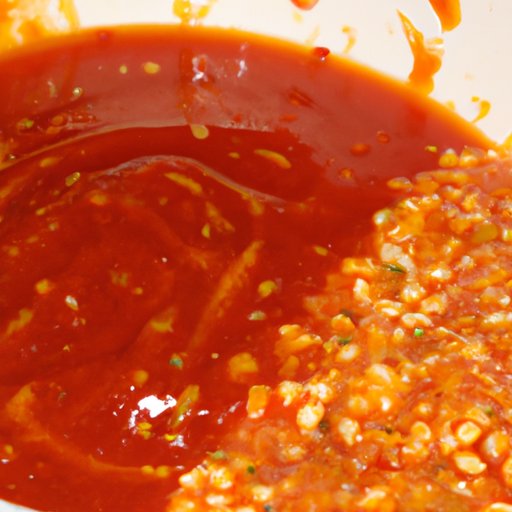
Introduction
Are you a pizza lover looking for a change from the usual tomato-based pizza sauce? Have you ever considered using pasta sauce as a substitute? If not, then you’re in for a treat! In this article, we explore the possibilities and benefits of using pasta sauce for pizza.
Whether you’re a pizza-making beginner or an experienced pro, pasta sauce can be a game-changer for your pizza recipes. In this article, we’ll cover everything you need to know to make the perfect pizza with pasta sauce, from step-by-step guides to creative topping ideas.
Recipe Inspiration: A Step-by-Step Guide on Using Pasta Sauce for Pizza
Making pizza with pasta sauce is easy and delicious. Here’s a step-by-step guide on how to do it:
1. Preheat your oven to 425 degrees F.
2. Roll out your pizza dough and place it on your pizza pan or stone.
3. Pour a generous amount of pasta sauce on your pizza dough, spreading it evenly with a spoon or spatula.
4. Add your desired toppings on top of the pasta sauce.
5. Sprinkle shredded mozzarella cheese on top of the toppings.
6. Bake your pizza in the preheated oven for 12-15 minutes, or until the crust is golden brown and the cheese is melted and bubbly.
Tips for Using Pasta Sauce:
– Look for a thick and chunky pasta sauce that will hold up well on the pizza crust.
– Consider adding some additional Italian seasonings or spices to your pasta sauce to give it an extra kick of flavor.
– Be sure to use a baking stone or preheated pizza pan for the best crust results.
From Pantry to Plate: 5 Reasons to Swap Pizza Sauce with Pasta Sauce
Using pasta sauce on your pizza has a lot of benefits! Here are five reasons why you should consider making the switch:
1. Rich Flavor
Pasta sauce has a rich, savory, and slightly sweet flavor that pairs well with pizza toppings. Unlike plain tomato sauce, pasta sauce is seasoned with a variety of herbs and spices, making it a flavorful addition to any pizza.
2. Versatility
Pasta sauce can be used in a variety of different sauce-based Italian dishes, making it a versatile ingredient to keep on hand in your pantry. Using it as a pizza sauce only adds to its versatility.
3. Convenience
Pasta sauce is a convenient and time-saving option for pizza-making since you likely already have it in your pantry. You can also buy pre-made pasta sauce at the grocery store for an even quicker pizza-making experience.
4. Lower Cost
Pasta sauce is generally less expensive than traditional pizza sauce, making it a cost-effective option for pizza-making.
5. Health Benefits
Pasta sauce can also be a healthier option for pizza sauce since it often contains fewer preservatives and artificial ingredients than traditional pizza sauces.
The Great Pizza Sauce Debate: Pasta Sauce vs Traditional Pizza Sauce
The debate over whether pasta sauce or traditional pizza sauce is better for pizza-making has been going on for years. Here are the pros and cons of each:
Pasta Sauce Pros and Cons:
Pros:
– Rich and savory flavor
– Chunky texture that pairs well with pizza toppings
– Versatile ingredient to keep on hand in your pantry
– Lower cost than traditional pizza sauce
Cons:
– Can be too sweet for some people’s tastes
– Thinner consistency than traditional pizza sauce, which may lead to a watery crust
Traditional Pizza Sauce Pros and Cons:
Pros:
– Specifically formulated for pizza-making
– Thick and tangy flavor that complements pizza toppings
– Consistent texture that won’t make the crust watery
Cons:
– Can be more expensive than pasta sauce
– May contain preservatives and artificial ingredients
Cooking with Convenience: Top Tips for Using Store-Bought Pasta Sauce on Pizza
Using store-bought pasta sauce is a convenient option for quick and easy pizza-making. Here are some tips for choosing and using the right kind of store-bought pasta sauce:
– Look for a pasta sauce with a thick and chunky texture for the best pizza results.
– Choose a pasta sauce with a low sugar content to avoid an overly sweet pizza.
– Consider adding additional Italian seasonings or spices to the store-bought pasta sauce to add an extra kick of flavor.
Don’t Knock It ‘Til You Try It: How Pasta Sauce on Pizza Might Just Change Your Mind
Some people may be skeptical about using pasta sauce as a pizza sauce substitute, but we’re here to change their minds! Here are some counterarguments to common objections:
– Pasta sauce can provide a more complex and interesting flavor profile than traditional pizza sauce.
– A little sweetness isn’t a bad thing and can even complement some pizza toppings.
– Pasta sauce can be less heavy and greasy than traditional pizza sauce.
Creative Cooking: Innovative Toppings to Pair with Pasta Sauce on Pizza
Using pasta sauce on your pizza can open up a world of creative topping options. Here are some innovative topping ideas to try:
– Grilled chicken and mozzarella cheese with a barbecue-style pasta sauce
– Fresh mozzarella, diced tomatoes, and basil with a garlic and herb pasta sauce
– Italian sausage, red onion, and green pepper with a spicy arrabbiata pasta sauce
Versatile Sauce: How to Use Leftover Pasta Sauce for a Quick and Easy Pizza Night
Don’t let leftover pasta sauce go to waste! Here are some creative ideas for using it up for a quick and easy pizza night meal:
– Use it as a dip for pizza crust or other appetizers.
– Spread it on a pre-made pizza crust for a quick and easy meal
– Use it as a topping for chicken or other meats.
Conclusion
In conclusion, using pasta sauce for pizza is a delicious and valid option for pizza-making that is worth considering. Whether you choose to make your own pasta sauce or use store-bought, there are plenty of benefits to giving it a try.




